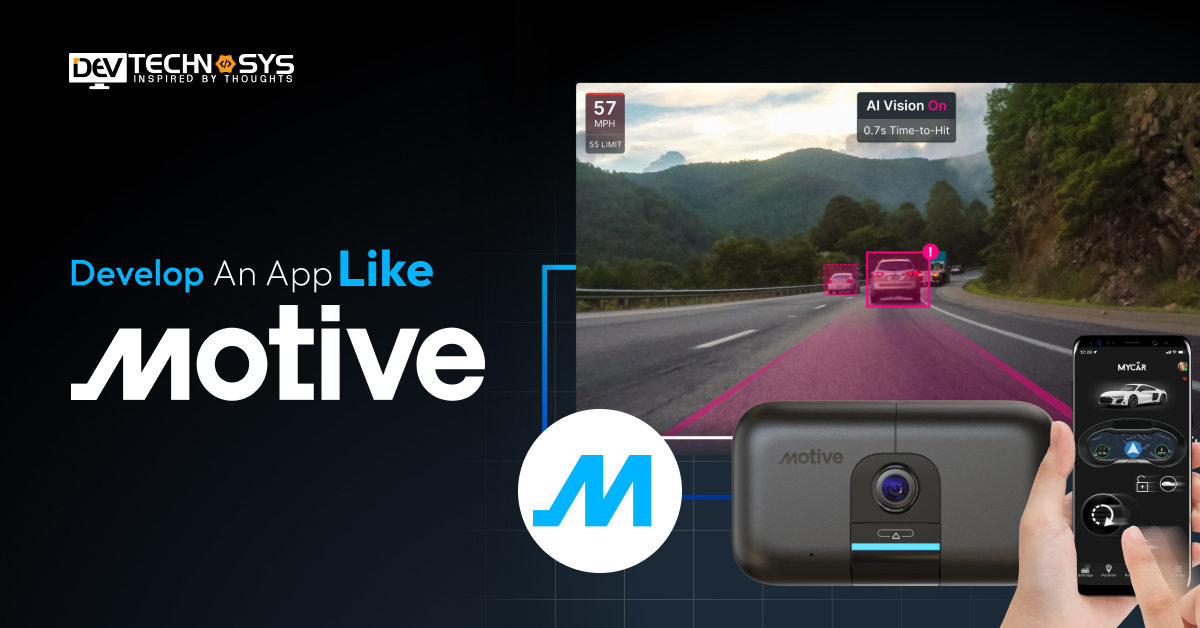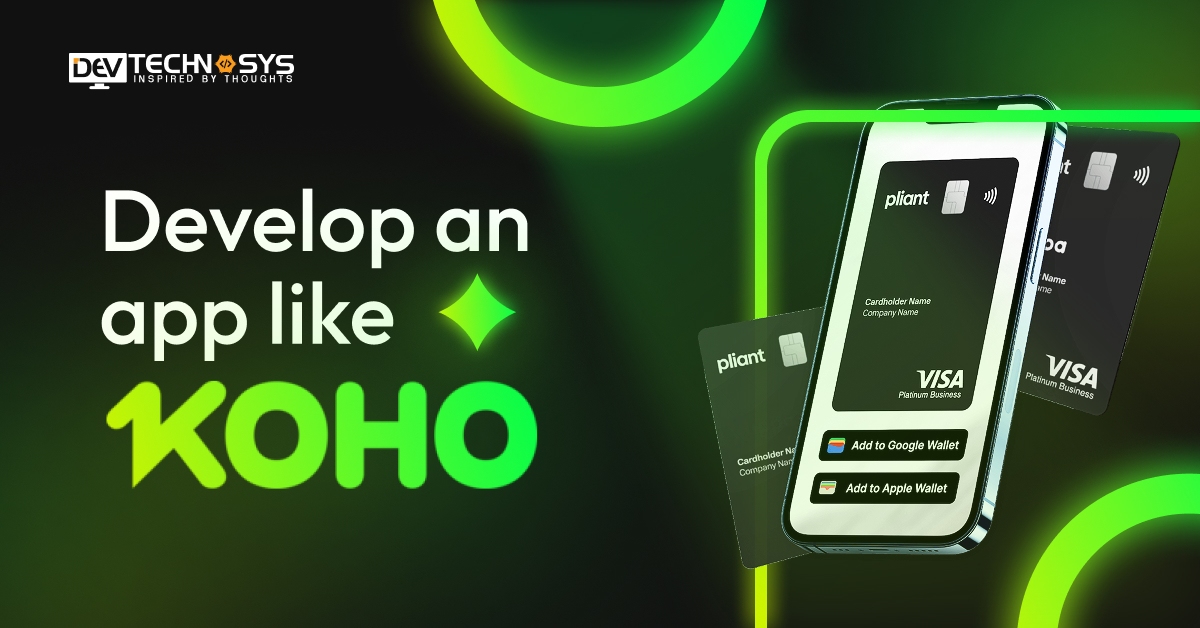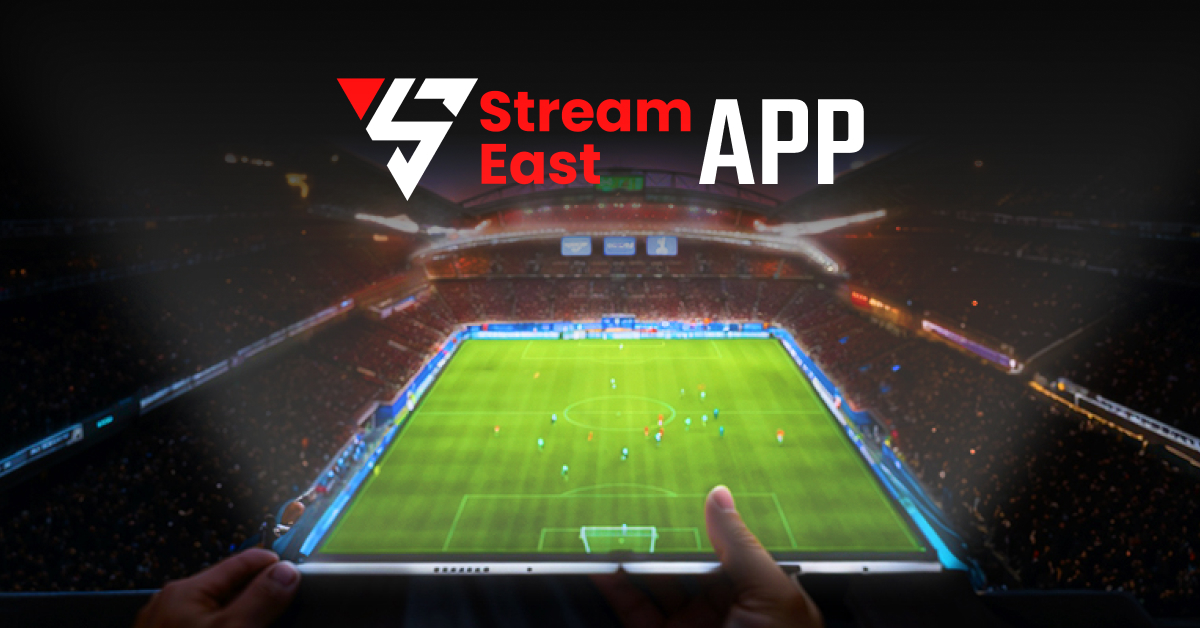“Organize your business work balance by creating apps similar to Motive Fleet.”
What if you are running a business and want to shift heavy equipment to different places? Or What if you fall asleep in your car? You require a smart fleet solution like Motive Fleet. As a business investor the primary task for you is to know the cost to develop an app like Motive Fleet after understanding about the platform and development process.
Inventory solutions are transforming the logistics industry as they are developed with the latest tools and technologies. Entrepreneurs must create an app like Motive Fleet to streamline all their business processes with task management.
Here, we will focus on major topics related to the development of such mobile applications. So, let’s begin with our blog.
What is Motive Fleet?
Motive Fleet is a top AI-powered platform for driver safety and fleet management that helps businesses to improve visibility, productivity, and compliance.
For real-time operations and data-driven insights, it combines GPS tracking, dash cams, ELDs, and maintenance tools into a single dashboard. It is easy to target Fleet management app development solutions with strong analytics and support infrastructure.
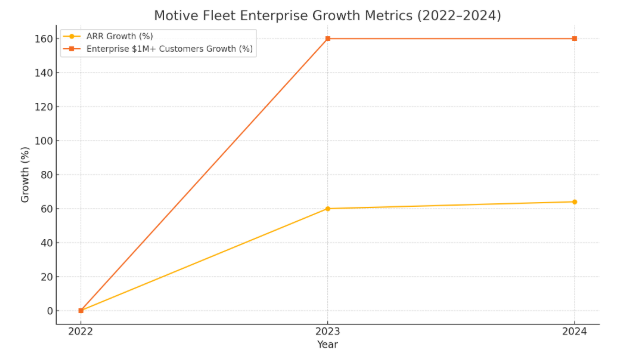
- Annual recurring revenue from enterprise customers surged over 60% year-over-year in 2023, showcasing strong market demand.
- Enterprise customers spending over $1 Million grew by 160% during the same period.
- By end of 2024, enterprise segment ARR rose 64%, with over 127% net revenue retention.
- Motive ranked as the top fleet management platform across all segments and outperformed competitors like Samsara and Lytx on G2.
- The platform serves more than 120,000 businesses in North America and Canada.
How Does Apps Like Motive Fleet Work?
By linking cars, drivers, and managers, apps like Motive Fleet simplify fleet operations. To provide real-time tracking, they make use of cloud computing, mobile apps, and Internet of Things sensors:
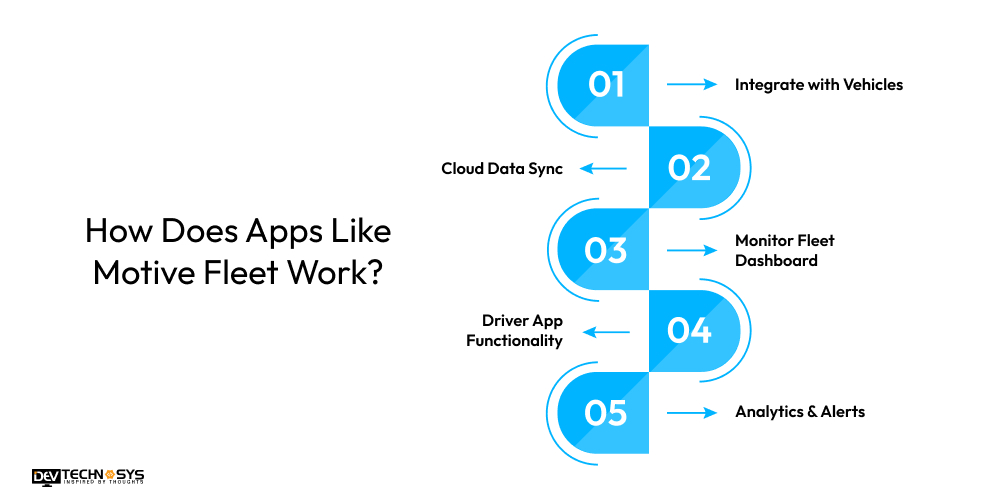
1. Integrate with Vehicles
A Motive Fleet app clone collects real-time data on movement, diagnostics, and driver behavior, the system establishes connections with automobiles via GPS trackers, dash cams, and ELDs.
2. Cloud Data Sync
Instantaneous uploading of collected data to safe cloud servers enables centralized storage. You can create an app for remote access with smooth data management.
3. Monitor Fleet Dashboard
To track routes, monitor fuel levels, assess idle time, and oversee maintenance and compliance, fleet managers utilize an online dashboard.
4. Driver App Functionality
In order to navigate, register their hours, receive assignments, and communicate with dispatchers. Businesses must use on demand app development services to make a mobile application for drivers.
5. Analytics & Alerts
In addition to sending out real-time alerts for problems like speeding, unlawful stops, or impending maintenance, the platform employs AI to identify inefficiencies.
Major Benefits of Developing Fleet Management Apps?
You can build an app like Motive Fleet to provide a digital way to track vehicle operations easily. They offer automation, real-time data, and insightful information to cut expenses and boost productivity:
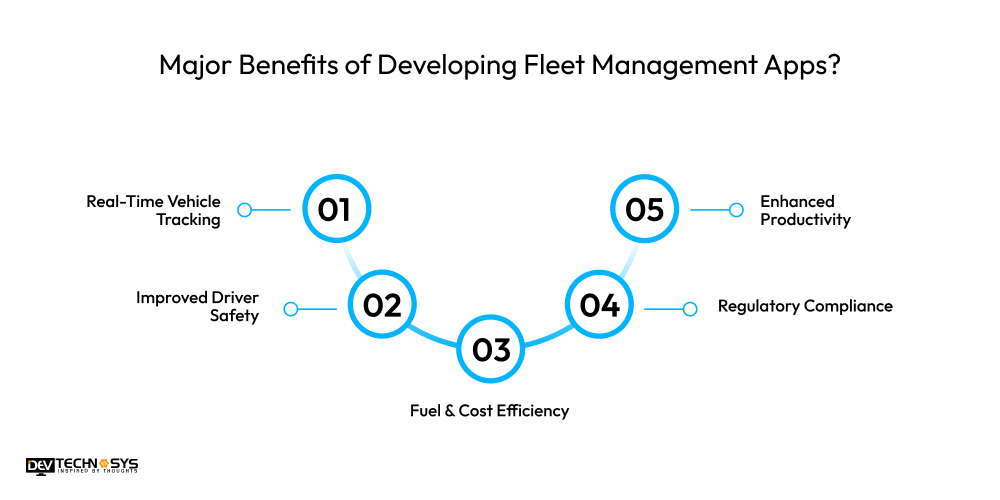
1. Real-Time Vehicle Tracking
These applications offer real-time GPS tracking, giving administrators rapid access to vehicle movements and positions. The use of Motive Fleet app development services raises field operations visibility, improves route planning, and promotes dispatch accuracy.
2. Improved Driver Safety
Fleet apps keep an eye on driver behavior, including speeding, hard braking, and idle time. In real time, they notify management of harmful practices and create safety scorecards. A driver app development company provides better driving practices, fewer collisions, and cheaper insurance are the results of this.
3. Fuel & Cost Efficiency
Idle time monitoring and intelligent route planning minimize fuel waste and maximize resource use. Applications assist in monitoring fuel usage trends and locating operational cost breaches. Businesses can create an app like Motive Fleet to see fuel and maintenance savings.
4. Regulatory Compliance
Fleet apps guarantee adherence to local transportation laws, including HOS rules and ELD requirements. You can develop a logistic management software with automatic record driving hours and vehicle health data. Legal risks are decreased with documentation and safety inspections are avoided.
5. Enhanced Productivity
Digital logs and automated task assignments do away with tedious paperwork and misunderstandings. For quicker decision-making, you can develop a fleet management app like Motive Fleet for managers to assign, oversee, and modify assignments in real time.
Why Use AI in Fleet Monitoring Systems?
By facilitating quicker, more intelligent, and more predictive decision-making, artificial intelligence greatly improves fleet monitoring. AI lowers the cost to build an app like Motive Fleet, enhances safety, and boosts operational efficiency. An iPhone app development company helps to manage fleet operations, from route optimization to predictive maintenance.
- Predictive Maintenance – AI detects early signs of vehicle issues, reducing breakdowns and maintenance costs.
- Route Optimization – AI algorithms analyze traffic, weather, and delivery schedules for the most efficient routes.
- Driver Behavior Analysis – Monitors speeding, harsh braking, and fatigue to improve driver safety.
- Fuel Consumption Insights – AI identifies patterns to minimize fuel usage and suggest economical driving practices.
- Automated Alerts & Anomaly Detection – Flags unusual activity, route deviations, or unauthorized usage in real time.
How to Create Logistics Applications Like Motive Fleet?
Let’s discuss the process to develop an app like Motive Fleet in this section. So, businesses can adjust their budget requirements without facing any challenge:
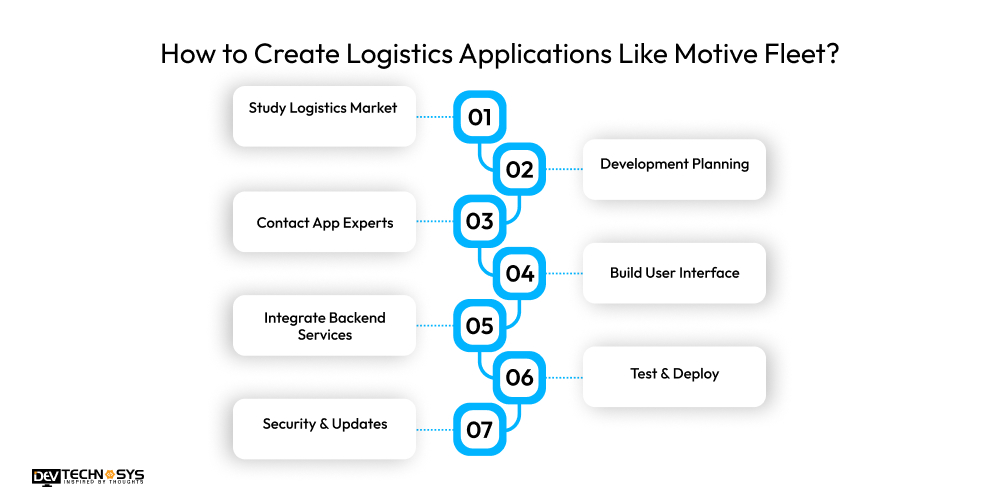
1. Study Logistics Market
To create an app like Motive Fleet, examine the market for fleet management and logistics by taking note of trends, rivals, and user issues. This is the first stage in the mobile app development process that helps to determine which features are used in apps like Motive Fleet.
Recognize your target market, which includes dispatchers, fleet operators, drivers, and compliance officials. Examine the legal requirements unique to the area you are targeting.
2. Development Planning
Establish the main features, objectives, and budget of your app after observing various business models. Select your technology stack to build an app like Motive Fleet, such as AWS/Azure for the cloud, Node.js/Java for the backend, and Flutter/React Native for mobile.
Arrange for the integration of ELD compliance tools, GPS, and IoT devices. Make a roadmap that details the development phases, team roles, deadlines, and milestones.
3. Contact App Experts
Hire a group with demonstrated logistics app experience to make an app like Motive Fleet. Make sure they are knowledgeable in cloud integration, telematics, fleet tracking, and mobile user experience. Talk about your goals and needs, and get input on their viability.
Request dates, cost estimates, and wireframes. To determine credibility, look at their prior work and customer reviews. Your idea is transformed into a secure application by knowledgeable professionals.
4. Build User Interface
Create a user interface that is easy to use for administrators, drivers, and fleet managers with different access roles. Prioritize accessibility across a range of devices by ensuring vehicle fleet management software development services. Include features like route tracking and live map viewing.
Prior to development, test UI flows and workflows using prototyping tools. Assure smooth transitions between jobs including trip history, route planning, and vehicle health.
5. Integrate Backend Services
Configure backend systems to facilitate route optimization, driver behavior tracking, and real-time GPS data. For data collection, connect to IoT devices such as fuel sensors, dash cams, and ELDs. Contact a Motive Fleet app development company to add admin panels, databases, cloud infrastructure, and APIs.
Make sure that the system can securely manage multi-user activity and large-scale data processing. Incorporate third-party logistical interfaces, payment gateways, and analytics dashboards.
6. Test & Deploy
To make sure the app functions correctly on all devices and operating systems, do thorough testing cycles. To get rid of defects, run usability, security, performance, and functional tests. Simulation of route logs, driving habits, and GPS data affects the cost to develop an app like Motive Fleet.
Conduct beta testing with a limited number of drivers or fleet operators. Prior to releasing to the App Store, Google Play, or enterprise use, addresses any problems.
7. Security & Updates
For all user types, incorporate secure login, two-factor authentication, and data encryption. Update the software frequently to fix bugs and adhere to evolving legal requirements. Use analytics tools and transportation app development services to keep an eye on customer feedback and performance.
Introduce new features based on the development of the market, such as driver scoring or AI analytics. Provide continuing technical assistance and guarantee firmware compatibility for devices.
Incredible Features of Fleet Tracking Apps
Apps for fleet tracking provide operational management and data-driven decision-making. To assure compliance throughout fleet operations and optimize logistics, they integrate GPS and smart analytics:
![]()
1. GPS Live Tracking
An application like Motive Fleet provides real-time vehicle location updates using GPS technology. Fleet managers can monitor movements instantly and improve dispatch efficiency and customer service.
2. Geofencing Alerts
Sets virtual boundaries around specific areas and sends instant alerts when vehicles enter or exit zones. Ideal for enforcing route adherence, detecting unauthorized usage, and enhancing security.
3. Driver Behavior Monitoring
Various inventory management apps track habits like speeding, harsh braking, and idle time to promote safe driving practices. Helps reduce accidents, fuel consumption, and vehicle wear and tear.
4. Vehicle Diagnostics
Monitors engine performance, battery health, and fault codes in real-time through OBD integrations. Ensures proactive maintenance and minimizes unexpected breakdowns.
5. Fuel Consumption Monitoring
Different similar apps like Motive Fleet analyzes fuel usage trends across vehicles to identify wastage and optimize fuel efficiency. Helps businesses lower fuel costs and reduce carbon footprint.
6. Electronic Logging Device (ELD) Integration
Top apps like Motive Fleet records driving hours automatically to ensure compliance with Hours of Service regulations. Reduces manual paperwork and supports regulatory audits with accurate logs.
7. Maintenance Scheduling
A fleet management application automates service reminders based on mileage, engine hours, or diagnostic alerts. Keeps the fleet in top condition and prevents costly downtime.
8. Route Optimization Tools
A similar app like Motive Fleet calculates the most efficient routes based on traffic, distance, and road conditions. Improves delivery timelines and reduces fuel consumption.
9. Mobile App for Drivers
An app similar to Motive Fleet empowers drivers to access assignments, navigation, logs, and communication tools on the go. Enhances operational coordination and simplifies reporting tasks.
10. Driver ID Authentication
The best fleet management apps ensure only authorized personnel operate fleet vehicles through biometric, RFID, or PIN login. Boosts accountability and prevents unauthorized vehicle access.
11. Dashboard Reporting
Top IoT fleet management solutions offer customizable dashboards with metrics on fuel, routes, driver performance, and more. Enables data-driven decision-making and performance tracking in real time.
12. In-App Messaging
Facilitates secure, real-time communication between drivers and fleet managers. Reduces dependency on external communication tools and ensures centralized coordination.
Top 6 Alternatives of Motive Fleet
A number of Motive Fleet alternatives provide strong features for logistics optimization, fleet tracking, and management. Here are the top 6 apps that offer different fleet sizes and operational requirements:
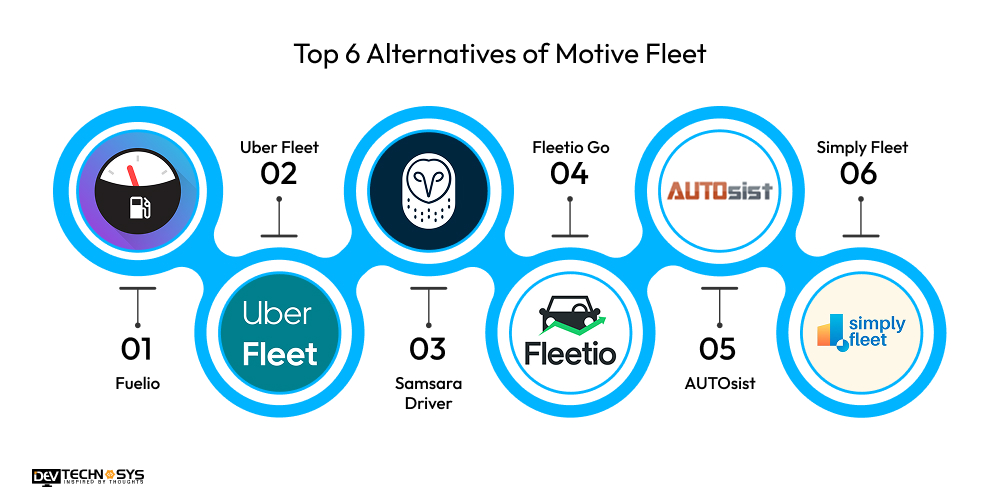
1. Fuelio
Fuelio is a fleet management solution that helps people and organizations keep an eye on car expenses, efficiency, and fuel costs. GPS tracking, route mapping, and the ability to export comprehensive logs for performance analysis are all supported.
2. Uber Fleet
Within the Uber ecosystem, Uber Fleet enables car owners to oversee numerous drivers, track trip statistics, and examine profits. For rideshare operations, it provides performance management, trip records, and real-time driver tracking.
3. Samsara Driver
An app like Samsara Driver provides real-time GPS tracking, driver workflow tools, and ELD compliance. Perfect for extensive fleet operations, it features live communication, document uploads, and safety scorecards.
4. Fleetio Go
A mobile fleet management tool called Fleetio Go provides repair orders, fuel tracking, maintenance scheduling, and vehicle inspections. Investment in fleet management app development allows businesses to deliver quicker resolution and view fleet statistics at any time.
5. AUTOsist
An easy-to-use program called AUTOsist is used to manage car maintenance, inspections, and service records. For more efficient fleet records and compliance, you can develop an app like Autosist and provide cloud storage with reminders.
6. Simply Fleet
For small to mid-sized businesses, Simply Fleet offers digital vehicle inspections, travel logs, and expense tracking solutions. To improve fleet efficiency, it facilitates fuel recording, document storage, and scheduling preventive maintenance.
Various Types of Fleet Management Apps
There are different types of fleet management applications available for logistics and transportation. These tools enhance productivity, safety, and compliance by handling drivers and maintenance:
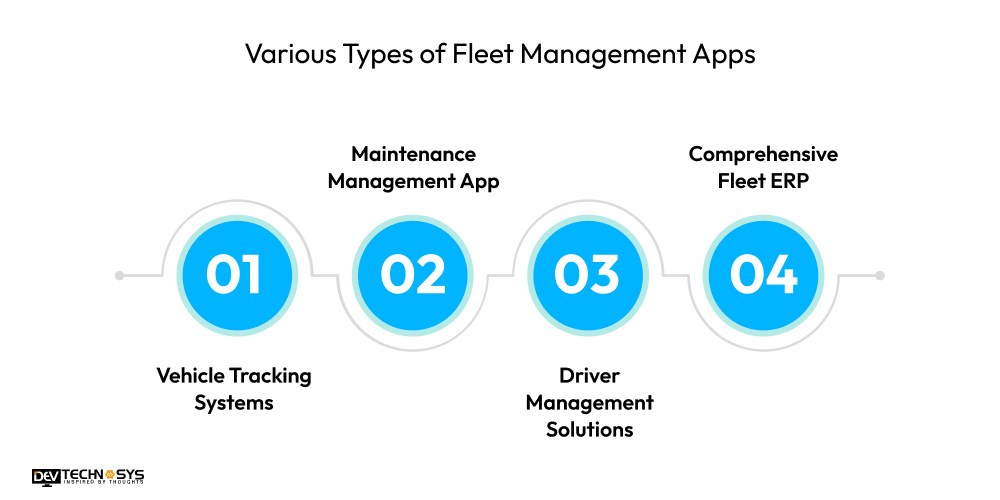
1. Vehicle Tracking Systems
With the use of these apps, supervisors can keep an eye on a vehicle’s location, speed, and adherence to the route in real time. Through live tracking, they are perfect for increasing dispatch accuracy, decreasing unauthorized use, and improving customer service.
2. Maintenance Management App
These apps track service history, log repairs, and plan preventive maintenance in order to keep an eye on the health of your car. An Android app development company guarantees prompt maintenance, decreases downtime, increases vehicle longevity, and avert expensive breakdowns.
3. Driver Management Solutions
Businesses must make an app like Motive Fleet to track behavior, log hours, manage driver profiles, and facilitate performance reviews. They increase driver accountability, compliance, and road safety.
4. Comprehensive Fleet ERP
Fleet ERP systems provide a single platform that integrates analytics, compliance, driver management, tracking, and maintenance. You can hire dedicated developers to improve scalability and strategic planning by offering centralized control over all fleet operations, making them ideal for large businesses.
Tech Stack Used to Develop an App Like Motive Fleet
A strong and scalable tech stack that guarantees performance, security, and real-time operations is necessary to reduce the cost to make an app like Motive Fleet.
Every element of the stack, from monitoring APIs to backend frameworks, is essential to provide a flawless MVP app development experience. A comprehensive table listing ten essential components and their particular applications may be seen below.
| Component | Use |
| React Native / Flutter | For building high-performance cross-platform mobile apps. |
| Node.js / Python (Django) | Backend development to handle APIs, logic, and user management. |
| MongoDB / PostgreSQL | Storing structured and unstructured data like trips, drivers, and logs. |
| Google Maps API | Real-time GPS tracking, route optimization, and geofencing. |
| Firebase / OneSignal | Push notifications, real-time alerts, and messaging. |
| AWS / Google Cloud | Scalable cloud hosting, storage, and computing infrastructure. |
| GraphQL / REST API | API architecture for secure communication between frontend and backend. |
| ELD Integration SDKs | Ensuring compliance with regulations like FMCSA (for U.S. fleets). |
| Stripe / Razorpay | Secure payment gateway for subscriptions and hardware purchases. |
| Kibana / Grafana | Dashboard and analytics visualization for admin monitoring. |
What is the Cost to Build an App Like Motive Fleet?
A number of factors affect the cost to develop an app like Motive Fleet. Understanding these elements aids in budgetary planning, resource optimization, and guaranteeing a successful product launch. Before beginning development, you should take into account these five cost determinants:
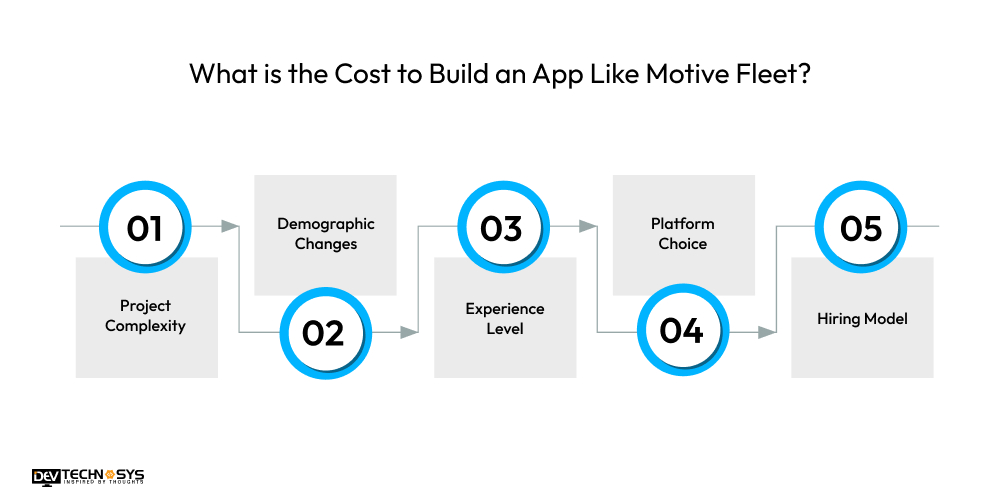
1. Project Complexity
The cost to build an app like Motive Fleet is impacted by the complexity of features like admin dashboards, GPS tracking, and ELD connection. Naturally, apps with more sophisticated real-time features, multi-role access, and data visualization will be more expensive than simple tracking programs.
| Project Complexity | Development Time | Estimated Cost |
| Simple | 2-5 months | $5000-$10000 |
| Moderate | 5-8 months | $10000-$15000 |
| Complex | 8-12 months | $15000-$20000 |
| Premium | More than 12 months | $20000-$25000 |
2. Demographic Changes
The cost to develop a fleet management app is influenced by your target market, and these factors raise development costs. An app designed for the US must adhere to FMCSA/ELD laws, but an app for the EU must take GDPR rules. Cost and feature design are also impacted by user behavior.
| Demographic Changes | Estimated Cost |
| USA | $25000-$30000 |
| Australia | $20000-$25000 |
| India | $5000-$12000 |
| UK | $15000-$20000 |
| UAE | $8000-$15000 |
| Brazil | $12000-$16000 |
3. Experience Level
Your development team’s experience has a big impact on the Motive fleet app development cost. Senior developers and agencies with experience in logistics solutions provide reliable products. Choosing budget developers could save money, but it will result in more technical debt over time.
| Experience Level | Cost Estimation |
| Junior/Entry-Level | $8000-$12000 |
| Mid-Level/Experienced | $12000-$16000 |
| Senior/Expert | $16000-$20000 |
| Professional | $20000-$24000 |
4. Platform Choice
The logistics app development cost is directly impacted by platforms like iOS or Android. Building distinct native apps can be more expensive than using cross-platform solutions like Flutter or React Native. Platform-based costs are further increased by backend infrastructure and third-party integrations.
| Platform Choice | Estimated Cost |
| Native App | $10,000-$15,000 |
| Flutter App | $15,000-$18,000 |
| Hybrid App | $18,000-$20,000 |
5. Hiring Model
Choice of a dedicated development business, freelancers, or an internal team will affect the Motive Fleet app development cost. Freelancers are more flexible, but they may not have full-stack capabilities. Optimal ROI is ensured by selecting the appropriate model according to the scope of your project.
| Hiring Model | Estimated Cost |
| In House Team | $5,000-$8,000 |
| Full-Time Freelancers | $3,500-$5,000 |
| Developer Outreach | $8,000-$15,000 |
How to Monetize Applications Like Motive Fleet?
Fleet management apps provide more than just subscription fees as a source of income. With the help of these six successful monetization techniques, you may make steady money from apps like Motive Fleet:
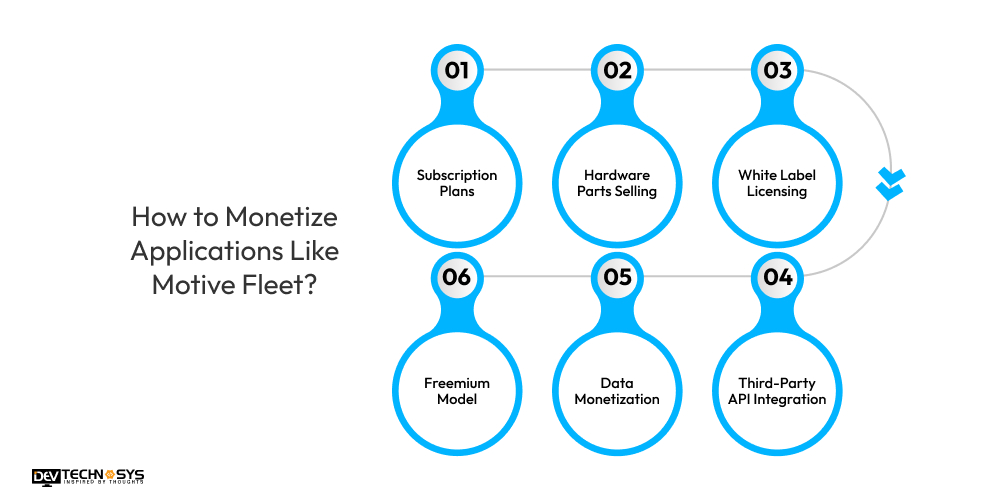
1. Subscription Plans
It is beneficial to hire mobile app developers to provide tiers of subscription packages according to fleet size. Businesses can grow services to meet their demands and guarantee consistent revenue with pricing. Customer service, integrations, and advanced analytics are all possible features of premium subscriptions.
2. Hardware Parts Selling
As part of your fleet ecosystem, sell dash cams, GPS trackers, ELD devices, or car sensors. Through smooth integration, combining the software and hardware boosts sales and enhances user experience. Additionally, it makes it possible to upsell hardware replacements and upgrades.
3. White Label Licensing
Give your fleet software licenses to resellers or other businesses who wish to sell it under their own name. A mobile app development company increases your market reach and generates a passive income. White-label solutions are perfect for logistics consultants and car rental companies.
4. Freemium Model
Give away free basic fleet management and tracking tools and charge for more advanced features. You can build an app like Motive Fleet to turn active users into paying clients and draw in a sizable user base. Freemium apps gather useful user information and comments to enhance subsequent products.
5. Data Monetization
Combine fleet consumption data to provide logistics experts, insurance firms, and fuel suppliers with insights. Vehicle health, traffic patterns, and driving habits help to reduce the mobile app development cost. Verify adherence to data privacy laws such as the CCPA or GDPR.
6. Third-Party API Integration
Apps and services from third parties that integrate with your software are charged. Providing API access as a service enhances your main product and generates new money. Additionally, this encourages developer engagement and reduces the cost to create an app like Motive Fleet.
Let’s Summarize!!
In this conclusion part, we will only discuss some important points that are necessary to develop an app like Motive Fleet. You have understood everything like development stages, cost, features, and monetization, so just follow the below points to become successful:
- Contact a reliable IT consulting company that offers services at lower rates.
- You can make an app like Motive Fleet by going through various business models.
- It is important to keep a flexible budget for app development.
- Use all monetary methods for profit generation.
If you want to establish a brand that manages all kinds of logistics operations, then following these points is necessary. With this, you can target audiences easily.
FAQs
Q1. Which are the Popular Fleet Monitoring Apps in the USA?
Motive, Samsara, Verizon Connect, Geotab, and Fleet Complete are among the most widely used fleet monitoring applications in the United States. These technologies provide driver behavior insights, fuel monitoring, ELD compliance, and real-time GPS tracking.
Q2. How Long Does it Take to Develop an App Like Motive Fleet?
Depending on complexity, creating a feature-rich app like Motive Fleet usually takes five to eight months. Planning, UI/UX design, backend development, testing, and third-party integrations are all included. The timetable might go longer if more complex features are needed, such AI diagnostics or ELD integration.
Q3. What is the Rate of Hiring Fleet App Developers?
Depending on the area and level of experience, hiring fleet app developers might cost anywhere from $10 to $80+ per hour. While overseas teams provide lower prices, US-based developers are more expensive. The price varies according to the level of expertise in cloud computing, telematics integration, or IoT.
Q4. How Much Does it Cost to Maintain Inventory Tracking Apps?
Inventory monitoring and fleet software may cost from $1,000 to $5,000 per month to maintain. This covers cloud storage, bug fixes, frequent updates, server hosting, and technical assistance. More complex systems with hardware support, analytics, and real-time syncing could be more expensive to maintain.
Q5. Which Industries Use Fleet Management Applications?
- Logistics – For real-time tracking and delivery management.
- Construction – To monitor machinery usage, fuel consumption, and maintenance.
- Public Services – Used by government fleets, waste management, and utility providers.
Q6. Do Apps Like Motive Fleet Provide User Data Security?
Yes, role-based access restrictions, secure APIs, and end-to-end encryption are used by apps like Motive Fleet to safeguard user data. To guarantee data privacy, they adhere to standards like the FMCSA, GDPR, and SOC 2. Cloud-based infrastructure and routine audits aid in protecting driver and fleet data.
